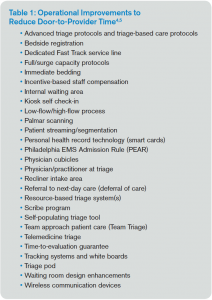Once upon a time, the emergency department was a single treatment room in the basement of a hospital. As utilization grew, the footprint of the ED grew, and by the 1980s, most EDs consisted of many rooms creating an entire department for urgent and emergent care. Emergency physicians discovered that patients with minor injuries could be treated and separated from the main department. With the right resources, patients could be treated and released in a more efficient manner by creating the “Fast Track” for high census times of the day. In the 1990s, emergency physicians at higher-volume centers found that some patients needed 24 hours to be adequately diagnosed and treated; the heyday for the ED observation unit began. These innovations were the tip of the iceberg, and performance-driven emergency departments have been experimenting with an array of models that segment patients into patient streams for more efficient health care delivery.1–3 The Supertrack (for very-low-acuity patients needing no resources), the pediatric ED, the geriatric ED, the CDU (clinical decision unit), and chest pain units are examples of patient segmentation currently employed across the country.
Explore This Issue
ACEP Now: Vol 34 – No 11 – November 2015The Raritan Bay Medical Center emergency department, with the support of Vincent Ciccarelli, MBA, BSN, ED nurse director, reinvented its intake process to quickly segment patients into appropriate areas within the department.
It is a fact: the world is watching the fishbowl that is the emergency department. Consumers, payers, and practitioners are intensely studying the Centers for Medicare & Medicaid Services’ emergency medicine performance metrics like OP-18 and ED-1a, capturing the length of stay of discharged and admitted patients, respectively. Also receiving attention is OP-20, the time from arrival to evaluation by a qualified medical provider. Here, too, we find a number of operational improvements emerging that improve the time it takes to see a provider (see Table 1).4,5
This month’s column will focus on a real success story from an ED trying to improve its front-end operations. Geralda Xavier, MD, MPH, the medical director at Raritan Bay Medical Center in Perth Amboy, New Jersey, wanted to improve the intake process for the emergency department. She found what other medium- and high-volume EDs have discovered. They are having success and gaining efficiency by quickly assigning patients to different streams based on specific criteria. The Raritan Bay Medical Center emergency department, with the support of Vincent Ciccarelli, MBA, BSN, ED nurse director, reinvented its intake process to quickly segment patients into appropriate areas within the department. This expedited the time to see the physician or other provider.
Pages: 1 2 | Single Page







No Responses to “Segmentation Improves Emergency Department Patient Flow at Raritan Bay Medical Center”